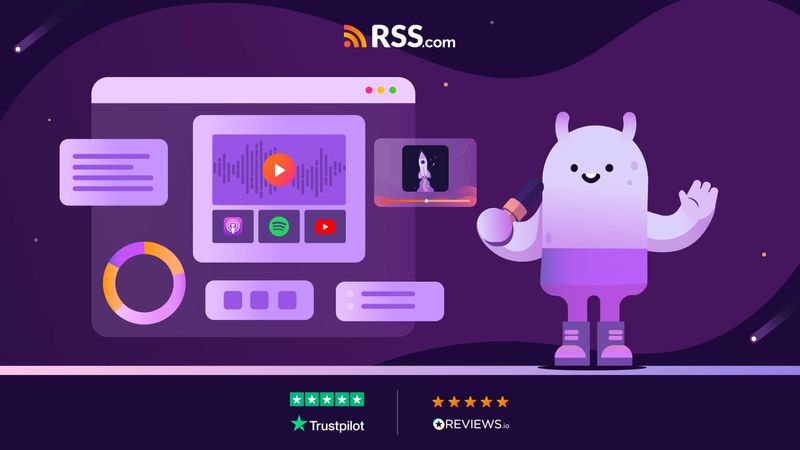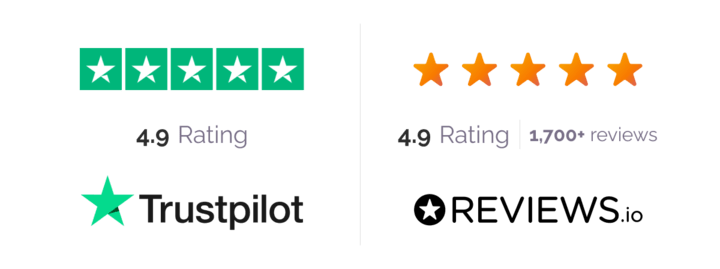Your podcast’s analytics are an invaluable tool to help you better understand your listeners, gain more followers and make money podcasting (potential sponsors will want to see your analytics!).
Let’s dive into what metrics and insights are offered in RSS.com’s Podcast Analytics and how to use them.
Podcast Analytics: What We Measure
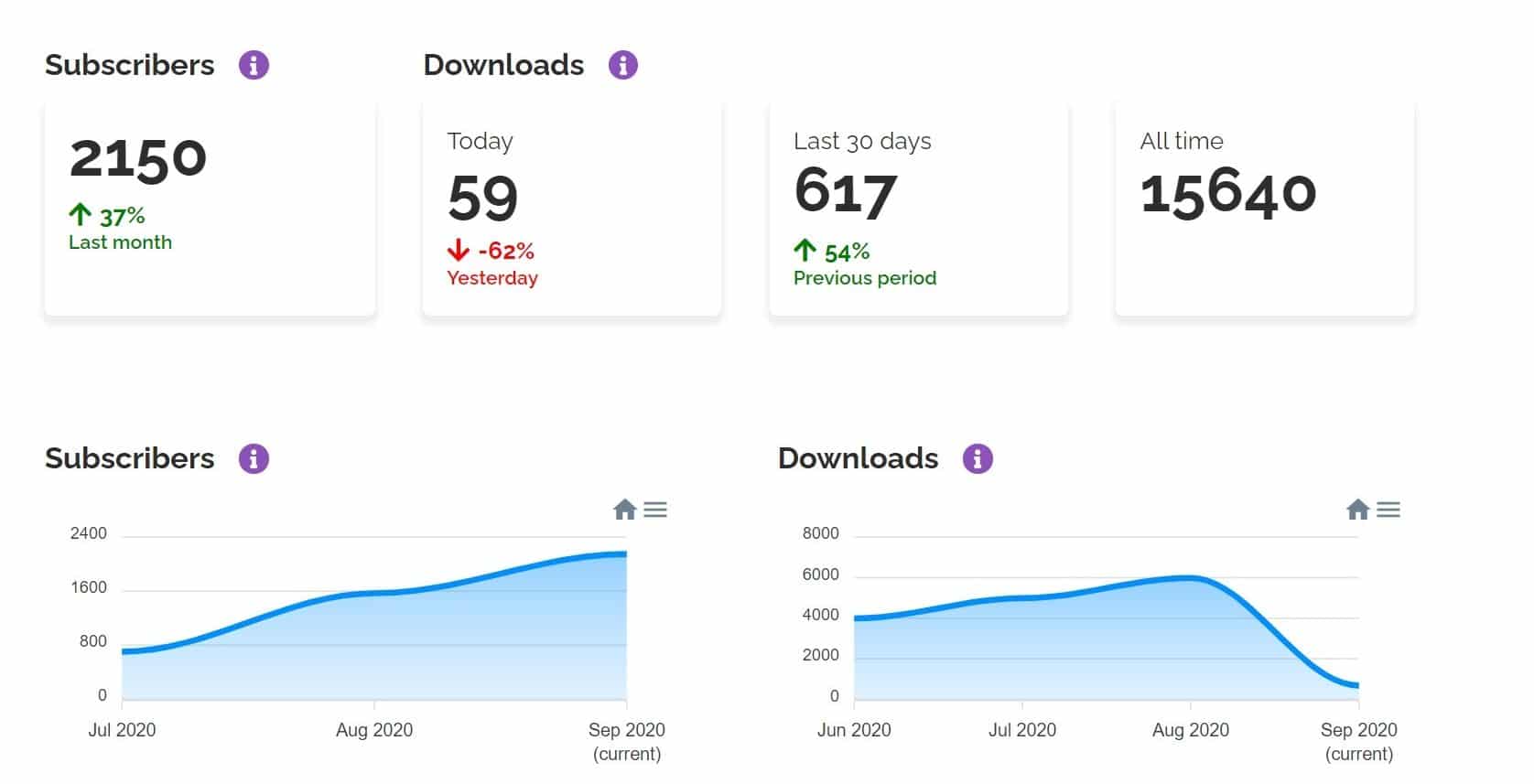
When you sign up for an RSS.com podcast hosting account, you get instant access to a robust analytics dashboard.
Once you have started uploading your episodes, you’ll be able to see the following metrics:
- Your downloads for today and for the last 30 days: refreshed on an hourly basis
- Total downloads (of all time): updated hourly
- Rolling Average Subscribers (RAS): Updated every hour for a 24 hour period following the release of a new episode
- Note: This metric requires a minimum of 3 published episodes to be measured. Once 24 hours have passed since the publication of a new episode, this value ceases to update until another episode is released.
- Learn more about RAS and get a better understanding of all the metrics we measure in our RSS.com Analytics Overview
- Downloads (trend): refreshed on an hourly basis
- Top episodes (5 episodes and all episodes): updated daily
- Top 5 locations and all geolocations: updated hourly (data displayed is from the past 6 months)
- Download distribution by location (World map): updated hourly (data displayed is from the past 6 months)
- Download time and Day of the Week heatmap: updated hourly (data displayed is from the past 6 months)
- Devices, platforms, client apps: updated daily (data displayed is from the past 3 months)
To access your Podcast Analytics, simply log in to your RSS.com account, and select “Analytics” in the top menu.
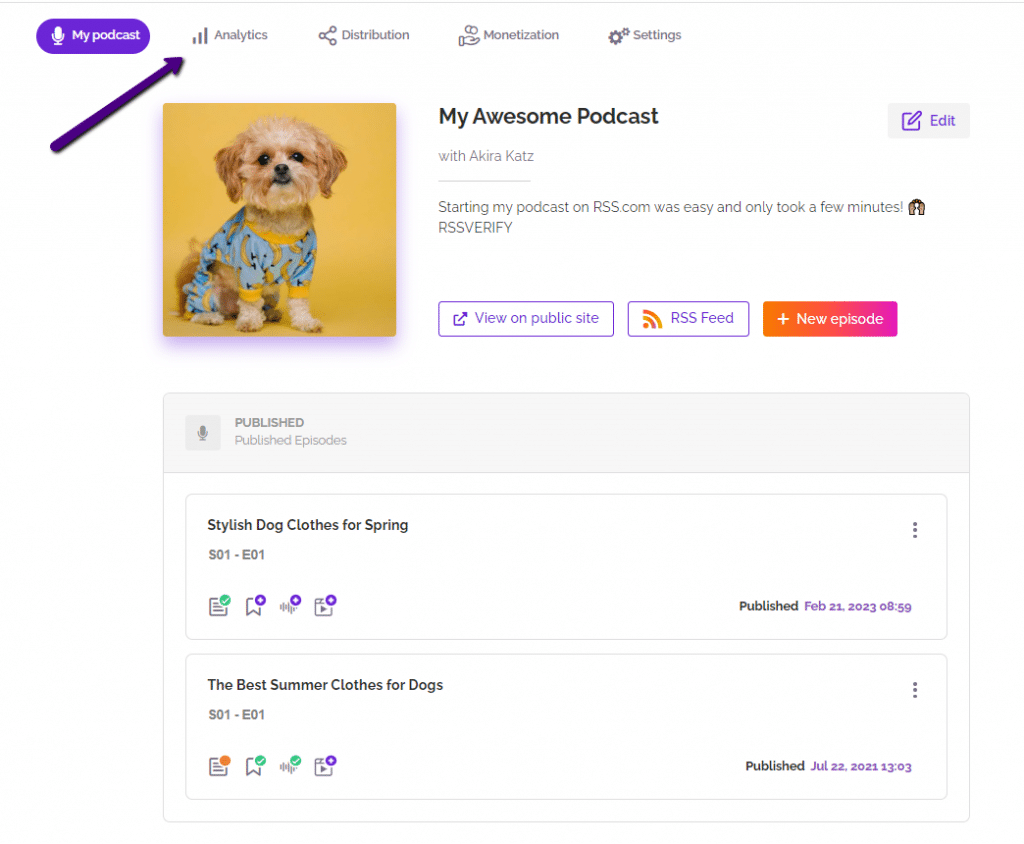
Why Your Podcast Analytics Matter
The metrics in your analytics will provide you with critical information that you can use to determine how your show is performing.
For example, suppose you start uploading episodes with a new theme or layout, and want to track whether or not the changes are resonating with your audience. You could send an email asking your audience how they feel about your new direction, but they might not want to tell you their actual thoughts. Numbers on the other hand don’t lie.
If the number of downloads decrease compared with previous episodes you’ve loaded, it’s a clear indicator that your audience isn’t as excited with your new direction. However, if you start seeing a massive uptick in downloads, it’s a pretty good bet that your listeners are enjoying the change and you should keep going on your current path.
Podcast analytics also helps you understand whether or not your marketing is working.
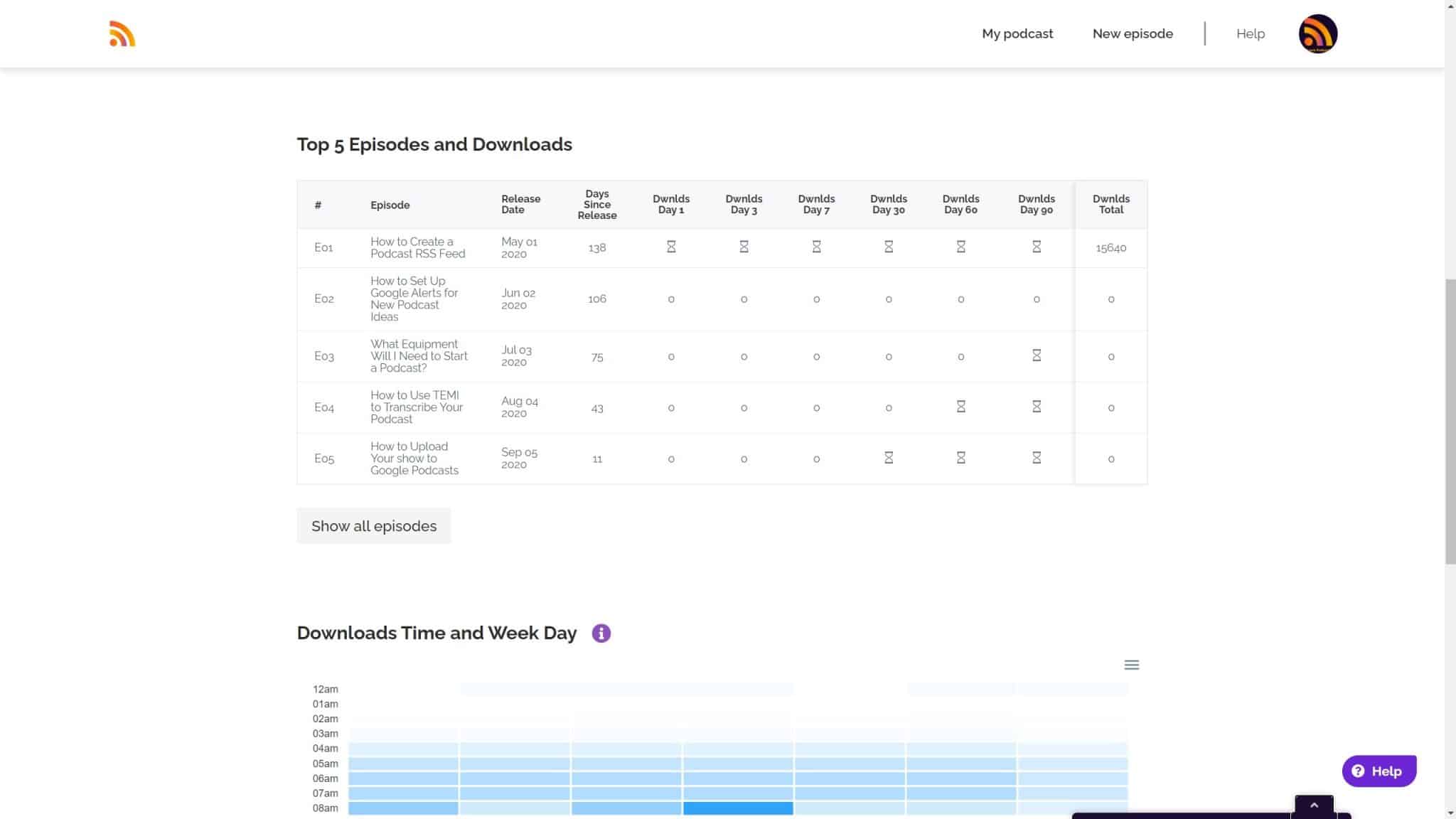
Assume for a moment that you’re heavily promoting your show on social media one month. If your subscriber numbers and downloads go up, it’s highly probable that your marketing efforts are doing what you want them to.
On the flip-side, if you’re not seeing any changes in the number of subscribers and/or downloads, perhaps social media is not the right place to be promoting your show. Then again, it could mean you need a different strategy if you want to continue using social media for your promotions. At this point, you could attempt paid advertising on social media and see if that moves the needle. The more information you can gather, the better.
Perhaps next month, your focus could be on securing better podcast guests. Or you could try getting booked on other podcasters’ shows in an effort to promote your own show. Every change you make should be examined through the lens of your podcast analytics so that you know what is working and what isn’t.
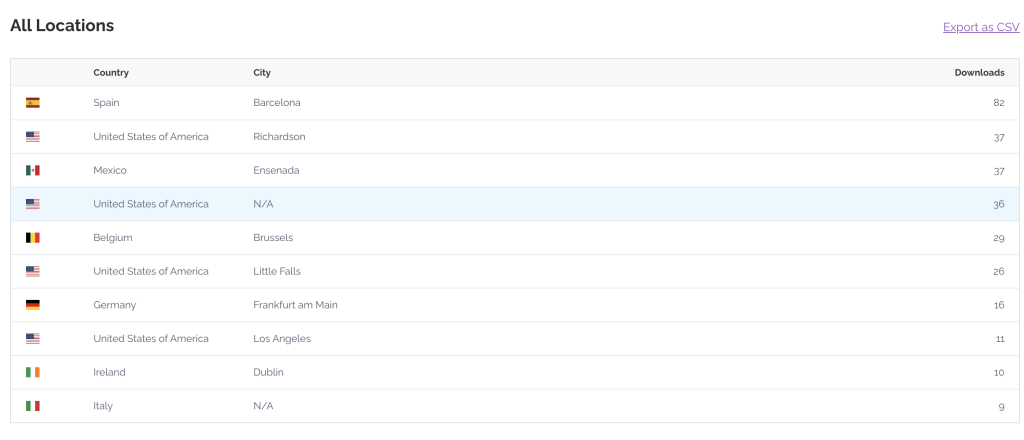
Note: Podcast analytics may not explain outlier events such as an episode suddenly going viral. The good news is, that while it’s true your show could randomly take off without a clear indication of what caused it to surge in popularity, your analytics can give you a lot of information under normal circumstances. In other words, if you start examining your analytics as you are working on your promotion efforts, you should be able to clearly see what worked and what didn’t.
Numbers going up means your efforts are working, while numbers staying stagnant or going down means your efforts have room for improvement.
💡 Pro Tip: Only make one change at a time as you are monitoring your analytics so that you know which change caused the movement in your numbers.
If you start making a bunch of changes to your podcast all at once, it will be harder to tell which changes positively or negatively impacted your analytics.
You can analyze click throughs from social media of course, but if you stick to making one significant change per month, it’s easier to determine what is most likely moving the needle for your show.

Podcast Analytics: Sponsors Want to See Them!
One final thing you should know about your podcast analytics is that they can be your ticket to sponsorships.
Because your analytics tell potential sponsors how popular your show is, that is what they use to determine if they want to invest with you. As your numbers increase, it’s a good idea to include your downloads per month in your media kit and/or advertising page on your podcast’s website. To paint an even better picture of your audience, you can also look at the analytics on Spotify, iTunes, and Google Podcasts.
These platforms can give you information about the demographics of your listeners such as the countries/regions they live in, the age ranges, and their gender. This information can help you hone in on specific sponsors you would like to pitch for your show.
Help Your Podcast Grow with Stats
Are you a visual learner? If so, check out the short video below for a full walk-through of our new analytics!
Putting Your Podcast Analytics into Action
This section is going to cover the immediate next steps you should take so that you can level up your podcast that much faster.
1. Listener Demographics Are Your Best Friend
Listener demographics are the features that set your listeners apart from the general public.
Consider factors like age, gender, and geological location (country and city), and you’ll be that much closer to connecting with your audience,
How do podcasting analytics capture this data? Don’t worry, listener information is safe. Instead of giving you individual user data, platforms like Spotify will supply general trend data about your entire podcast listenership.
When you understand who your audience members are, you have a much better idea of how to relate to them. This relatability and mutual understanding goes a long way when it comes to being a sensational podcaster.
Understanding your listener demographic applies to more than just your podcast content. When formatting campaigns or other marketing strategies, these analytics will sway you towards making the most informed choices.
For instance, if you have a particularly strong following in one city – use that to your advantage! Consider adding a guest to your podcast with strong roots from that city. Or, maybe you could host a meet-and-greet hangout with your fans in a nearby area too. The sky becomes the limit when you understand your listener demographics.
2. Improve Your Podcast By Analyzing Episode Download Time
One of the easiest ways to improve your podcast is to analyze download time.
This metric gives you a bird’s eye view of when listeners are downloading your episodes by time and day of the week.
How will this help you ask?
When you know the time and day your listeners are most likely to be downloading episodes, you can capitalize on that by releasing of scheduling your episodes, and sharing social media updates at those specific times.
It may also help you determine when is the best time to release additional episodes if you choose to increase how frequently you release new content.
3. Plan Your Future Content Around Your Previous Hits
Not all podcasts are created equal. In fact, not all episodes of a single show are created equal either.
While you should be proud of all the content you produce, certain episodes will naturally garner more views and engagement than others.
The top 5 episodes and downloads metric will reveal the episodes that have received the most love and attention. If you mirror the duration and type of content as your previous hits, your listeners will be that much more likely to love your future content as well.
Here’s another way to think about it. Pretend you manage your own grocery store. At the end of the day, you always run out of milk but always have pretzels left over. Which would you prioritize? Because the milk — aka your previous hits — are in demand, you would buy more for customers to consume.
4. So, What’s Everyone Listening On?
Ever consider this question? Well, the answer’s within your grasp with podcast analytics! The listening platform section of your RSS.com analytics can tell you which apps and devices people use to listen to your podcast.
With this insight, you can plan accordingly. If a majority of your viewers are on mobile platforms, for example, you may choose to make your episodes on the shorter side because you know your listeners are on the go.
On the other hand, if most viewers are on desktop, you might want to consider podcast episodes that are on the longer side. Listening on a desktop often means the listener is going to remain in one location until the episode is over.
This can also be an indicator that it’s a good idea to start creating video podcast episodes as desktop listeners tend to enjoy visual stimuli as they listen as well.
📘 Related Reading: Learn how to start a podcast on YouTube.
How to Interpret Podcast Analytics from Different Platforms
Many podcasters will notice differences between the numbers we provide in our analytics vs the numbers being reported by Spotify, Apple Podcasts and Google Podcasts.
This inconsistency is due to two main reasons:
1. Terminology – These apps and platforms use similar labels that often represent different calculations. For instance, we estimate “Followers” by calculating the average of the first 24 hours unique downloads for your last 3 episodes, whereas Spotify “Followers” indicate the number of people who click the “Follow” button on a podcast in the Spotify app.
2. Caching – Some podcast apps may cache i.e. store your episode in their servers or locally. Platforms that cache your content typically don’t disclose how and when they do so. Spotify, for instance, is well known for caching your episodes, and in some cases, this may result in discrepancies in the number of downloads and followers being reported in RSS.com’s Analytics and Spotify’s Insights.
For example, if one of your episodes is downloaded once via Spotify and it gets cached, it’s possible that multiple listeners streaming it in Spotify will result in only 1 download displayed in our Analytics. This is a common problem for all podcast hosting services that requires more collaboration across the industry.
Metrics That Are Specific to Apple, Spotify, and Google
There some very useful metrics that are specific to Apple, Spotify, Google and other platforms that only they can offer.
For example, the reason why Spotify and Apple can provide metrics such as listeners’ demographics and we can’t, is that these users have been authenticated (logged in) and they have access to demographic insights on who is listening to your podcast.
This is useful, but still not comprehensive as Spotify can provide insights such as demographics, streams and starts for the people who listen to your show via Spotify but not for listeners that use Google Podcasts or Apple Podcasts.
Similarly, Apple Podcasts can provide you with the percentage of Engaged Listeners and Average Consumption only for users that listened to your podcast via Apple Podcasts and not via Spotify or Google Podcasts.
For this reason, podcasters will typically merge data from their hosting service with the platform-specific data offered by companies like Spotify, Google and Apple.
✨ To learn more about the specific features of RSS.com’s podcast analytics, including how downloads and subscribers are calculated, click here.
More Good Reading 📘
- How to Understand Podcast Stats
- The Difference Between Streams & Listeners on Spotify
- Quick Guide to Spotify’s Podcast Metrics
- Apple Podcasts: Measure Your Podcast’s Performance
- Spotify for Podcasters
- How to Submit Your Podcast to Spotify
- Accessing iTunes Podcast Analytics
- How to Submit Your RSS Feed to iTunes
- Viewing Your Google Podcast Reports
- How to Get Your Podcast on Google Podcasts and Google Home
- How To Make A Podcast Media Kit
- How to Start a Podcast: A Step-By-Step Guide

